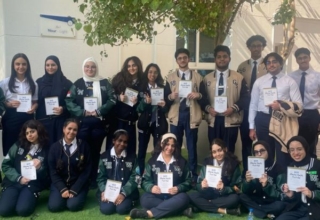
The union budget proposals for the financial year beginning this April, which was presented in the Parliament on February 28 by Finance Minister Arun Jaitley, contains some definite good news for education & skills sectors. When, how and to what extent these key announcements materialize, is something all of us have to look forward to in coming months after the proposals are passed.
Government has decided to set up National Skill Mission, proposes to establish ATAL Innovation Mission (AIM) and a student Financial Aid Authority to administer and monitor scholarships and educational loan schemes via Pradhan Mantri Vidya Lakshmi Karyakram. While delinking the scheme for setting up of 6000 Model Schools from budget allocation, the central government will fully support SSA, Mid-day meal programs and National Nutrition Mission. Govt also plans to upgrade over 80,000 secondary schools and add or upgrade 75,000 junior/middle to the senior secondary level to ensure that there is a senior secondary school within 5 km reach of each child. An integrated education and livelihood scheme called ‘NaiManzil’ for dropouts from minority communities is also expected to be rolled out. There is a proposal to set up SETU (Self-Employment and Talent Utilisation) as a techno-financial, incubation and facilitation programme to support start-up business through an allocation of Rs. 1,000 crore under the National Institution for Transforming India (NITI) Aayog.
At the same time, the Education Budget has seen a decrease of 2.02 percent from last year and budget for children has seen a drastic cut from 4.52 percent to 3.26 percent . School education and higher education sectors have got Rs 69,074 crore. While the school education sector has got an outlay of Rs 42,219.50 cr for 2015-16, the higher education sector has got Rs 26,855 cr. National Skill Mission gets Rs 1500 cr
THAT EDUCATION PLAYS A KEY ROLE IN the realization of a country’s extraordinary potential and aspirations for economic and technological development is gradually becoming apparent on the minds of policy planners and leaders has become evident to some extent in this year’s budget proposals. Though the education sector saw over a two per cent cut in the outlay from last year, yet a marked emphasis on skilling, innovation, incubations and support to student entrepreneurships and educational loans point to an innovative mindset of the government. The government has also proposed to set up new IITs and IIMs in some states.
The thrust has been on the higher education sector with the announcement of an IIT in Karnataka and upgradation of Indian School of Mines, Dhanbad into a full-fledged IIT. IIMs will be setup in Jammu and Kashmir and Andhra Pradesh. Finance Minister also announced setting up of several institutions which include Institutes of Science and Education Research in Nagaland and Odisha, a Centre for Film Production, Animation and Gaming in Arunachal Pradesh and Apprenticeship Training Institute for Women in Haryana and Uttarakhand. A Post Graduate Institute of Horticulture Research and Education has also been proposed in Amritsar and upgradation of the existing National Institute of Speech and Hearing in Kerala into a University of Disability Studies and Rehabilitation. Three new National Institutes of Pharmaceutical Education and Research will come up in Maharashtra, Rajasthan, and Chhattisgarh. Similarly setting up All India Institutes of Medical Sciences (AIIMS) in Jammu and Kashmir, Punjab, Tamil Nadu, Himachal Pradesh and Assam have been proposed. “Proposal to open 5 new AIIMS and an IIT in Karnataka is a welcome step along with giving IIT status to ISM Dhanbad which is India’s one of the oldest technical institute is also a positive step towards improving quality of education and expansion. It will definitely boost our prospects to more parts of the country. Increased availability of loans for higher education will also motivate aspirants to pursue engineering and medicine career without much pressure on entering job markets,” said Aakash Chaudhry, Director, Aakash Educational Services Pvt, Ltd.
Piggybacking Skill India on Make in India vision, the Finance Minister Jaitley in his speech said, “We will soon be launching a National Skills Mission through the Skill Development and Entrepreneurship Ministry. The Mission will consolidate skill initiatives spread across several Ministries and allow us to standardize procedures and outcomes across our 31 Sector Skill Councils… With rural population still forming close to 70% of India’s population, enhancing the employability of rural youth is the key to unlocking India’s demographic dividend. With this in mind, we had launched the Deen Dayal Upadhyay Gramin Kaushal Yojana. ` 1,500 crore has been set apart for this scheme. Disbursement will be through a digital voucher directly into qualified student’s bank account.”
According to Puneet Rathi, Advisory & Knowledge Head, SHRM India, “Giving options of picking skills even at school level indicates that the government understands the significance of skill development. This will make people job ready as soon as they complete school. When compared to countries like Korea, our vocational skills are very low, the Government recommendations in the budget will help in improving vocational skills of the youth of our country. The announcement of launching a national skills mission will further enhance employability in rural areas which will in turn add to country’s economic growth. The only challenge before the government is to make it happen and let it not remain as good ideas.” While this is concern of many, at the same time Dr. Prashant Bhalla, President, Manav Rachna Educational Institutions, Faridabad sees consolidation of skills initiatives spread across ministries under the National Skills Mission as a very positive step to develop youth employability.
As per Rakesh Jinsi, President SOIL, the budget definitely attempts to address India’s demographic dividend concern opportunities for the youth. It turns the spotlight on both sides of the potential growth story job creation as well as skill up-gradation. On the job creation front, apart from Make in India, three things stand out. Firstly, the plans to increase the ease of doing business this will attract more investments and will speed up the process of creating opportunities. Secondly, the allocation of 1000 crore towards SETU (Self Employment and Talent Utilization) through NIITI Aayog an interesting development will be keen to see how this is implemented. Thirdly the proposal of the MUDRA bank to fund the unfunded will encourage more Indian youth to take to entrepreneurship rather than seek jobs alone. According to Prof. Rupa Manjari Ray, Assistant Professor, Economics,MDI Gurgaon, the budget proposals for 2015-16 have a clear focus towards skilled India. It envisions building India through encouragement to the young entrepreneurs and youth. To incentivize the growth of young talent in India, allocation of 1500 cr under the National Skills Mission for skill development and entrepreneurship will enhance employability of rural youth. The budget also envisages on providing assistance to the budding entrepreneurship segment. “To support this, the govt. is establishing a mechanism for techno-financial incubation and facilitation programme with an allocation of Rs. 1,000 crore. Industry academia gap has been a major issue. There was a need to foster the culture of innovation and research in India. Also, the proposed Atal Innovation Mission with 1500 cr will boost the academicians, Entrepreneurs and researchers to work towards innovation,” she says. “We are happy to see that the budget has announced that the education cess will now be a part of GST, however the increase in percentage is worrisome. The education industry was looking forward to support towards skill development and the Rs.1500 crore allocation to National Skills Mission for skill development and entrepreneurship is a welcome move. However, tt was disappointing to see no consideration in exempting tax on non degree-education / vocational education and vocational training as levying service tax on such educational activities is detrimental to the proliferation of up-skilling of the country, “ feels Meghna Ghai Puri, President, Whistling Woods International, Mumbai. “The budget is Government’s vision statement and it all depends on the execution and effectiveness of the ‘Skill India’ program and the other initiatives announced on ground, but there is no doubt that with this new rigor and focus towards skill development, India is swiftly moving towards improving the employment scenario and building entrepreneurs that will benefit the nation.” Says Sachin Adhikari, Chief Mentor of Viztar International.
School education which makes up 80% of India’s total education expenditure, with 50% of the budget allocated for elementary education and 30% for secondary education contrary to the past misses the emphasis it should have got though the announcement on up gradation of 80,000 schools was made. The ambitious programme of setting up of 6,000 Model Schools has been delinked from the central assistance and has been put to the state basket.
“The Government’s reiteration of its commitment to educating the youth and ensuring that there is a senior secondary school within 5 km of reach of each child is welcome. The current outlay of Rs 68,968 crore seems less than adequate to achieve this target, since a school is not just the building its prime requirement are qualified teachers too. The expectations of the education sector for some radical announcements did not materialize and I would say the Budget largely maintained the status quo as far as the social sector is concerned. The Government’s focus in Budget has historically been on higher education, and the same continued in this Budget too,” opines Samik Ghosh, Principal Scindia School, Gwalior. According to him, while the setting up of the Student Financial Aid Authority to administer scholarships for higher education is a commendable move, much more could have been done to expand the primary education opportunities available to the poor and underprivileged sections, which is a huge challenge for India. “ I wish the government had raised tax deduction limit for tuition fee for school students to lessen the burden of education costs for middle class parents. The Government also needs to focus on providing education to mothers of poor children through afternoon and evening schools. This area still remains completely neglected. Also, hope the Government’s drive to construct toilets in elementary schools transforms into a larger drive to upgrade physical infrastructure and digital technology related to primary education across the country so that India’s demographic dividend can stay an asset and not become a liability,” he adds. According to KVS Seshasai, CEO Zee Learn Ltd, there are no specific allocations towards teacher skill development and training which is critical for improving quality of education in schools. Also, we expected some incentives and ease of approvals for corporates foraying in education through softer loans and step up repayment plans. Tax benefits to corporates investing in research and development of content is another area where we expected some positive announcements but did not see anything on from the budget.There are some welcome voices particularly to expansion announcement. According to Sameer Bora, EVP Research & Development, Next Education India Pvt. Ltd., the government’s decision to upgrade 80,000 rural secondary schools will bring education to the last tier, where it’s needed most. Direct bank transfer for skill building is also a very welcome step. Overall, this is a budget that aims at reducing inefficiency and giving good momentum to genuine companies. “Such steps would effectively enable more children to attend schools and be part of the country’s growth story. However, we are disappointed that the persistent and legitimate demand from the education sector to exempt schools from service tax on outsourced services has not been met. This will certainly increase the burden on parents across the spectrum” said a statement from Shantanu Prakash, CMD, Educomp Solutions Ltd. According to Deepak Mehrotra, MD, Pearson India, the budget promises to start a school assessment programme and aims to infuse new training tools and initiatives to motivate teachers. This is a step in the right direction as the lack of trained teachers is a big hurdle in improving education outcomes. The budget however lacks clarity on the question of private investment in education and doesn’t provide fiscal incentives to attract private sector investment in education sector.
Child activists feel left out in the budget. “One of the areas we would have liked to see given emphasis is Early Childhood Care and Education (ECCE). The formative years between 0 – 8 age group are crucial for physical, intellectual, language, emotional and social needs for holistic development. In fact 90% of brain development takes place between the ages 0-6 years. These are the years that children form skills needed to be school ready and life ready. Despite this, education spending in India has been historically lower than the world average. It is time the government started providing priority budgeting to address early childhood in India.More focus on strengthening the early childhood education component will also go a long way for India to meet its Millennium Development Goals (MDG). Improving safety guidelines for preschools, setting benchmarks and training for early childhood educators and investing in providing content that can enable children to grow up with 21st century skills is the need of the hour”, says Sashwati Banerjee, Managing Director, Sesame Workshop in India. She is seconded by Komal Ganotra, Director, Policy, Advocacy & Research, CRY – Child Rights and You, who says the Union Budget 2015-16 has seen sharp decline in the Child Budget as proportion of Total Union Budget to 3.26 percent from 4.52 percent of the Total Union Budget in 2014-15 (BE). In absolute term, child budget has declined from Rs. 81075.26 crore in 2014-15 (BE) to Rs. 57918.51 crore. A close look at Statement 22, that provides details of children’s share also illustrates this, with massive cuts in Sarva Shiksha Abhiyan (22000 crore from 27758 crore (BE) in 14-15), mid day meal scheme (9236 crore as against 13215 crore (BE) in 14-15), ICDS (Rs. 8335.77 crore from Rs. 18195 crore in 2014-15 (BE). The Government has claimed that the states, with a larger pool of untied funds through devolution of Union Taxes as recommended by the Fourteenth Finance Commission (FFC), shall be contributing the difference from their enhanced resources. “The overall scenario in terms of children’s share is that of uncertainty and ambiguity, since it will depend to a large extent on the priority accorded by each state to children’s issues and requirements. The worry therefore is that if the devolution to the states as well as the additional expectations from the taxation benefits do not come through, it shall definitely be a blow to the survival and development of the children,” she adds
Experts say the overall look out for social sector from this budget is average. The focus on skill development is a measure in right direction. Not much has been talked about in budget speech on other flagship programs largely initiated by previous government. The allocations and resource sharing arrangement with states may change on basis of recommendations of 14th finance commission and therefore the impact on schemes need to be studied in detail. “The total central share in these schemes has dropped by a significant 44% (BE) or 24% RE. The expectation is that the centre-state sharing pattern will be redesigned to enhance state contribution so that the overall expenditure does not see a significant reduction going forward,” according to an opinion article by Yamini Aiyar is senior research fellow, Centre for Policy Research, and director of the Accountability Initiative. Education is key for the upliftment of any society and country; therefore it was somewhat disappointing not to see that kind of emphasis on education in this year’s budget, but as said in the beginning a gradual mindset change at the top has at least started. And there is always next time to hope for better.










